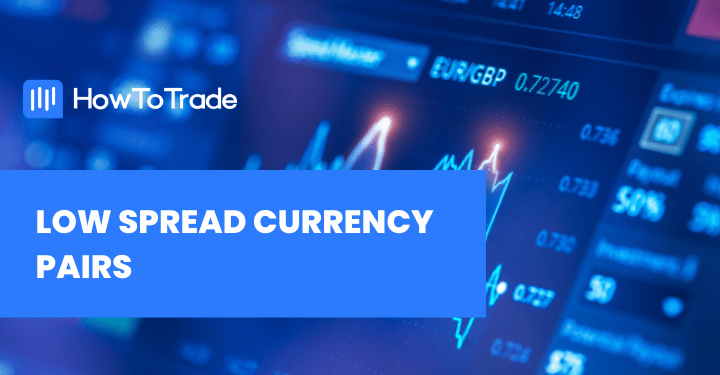
- Choosing currency pairs with low spreads is crucial for short-term traders aiming to maximize their profitability and efficiency
- Major currency pairs are advantageous for traders because they typically come with lower spreads
- Traders can choose fixed or variable spreads, depending on their trading style, and strategy.
As a forex trader, the frustration of watching potential profits dwindle due to high transaction costs is a common pain point, especially for those engaged in short-term trading.
Every pip counts, and finding ways to minimize costs without compromising your trading strategy is essential. This is where the concept of low-spread forex pairs comes into play.
In this article, we’ll go deep into why choosing currency pairs with low spreads can be a game-changer for your trading strategy. Here’s what you’ll learn:
- What is a Forex Spread?
- The Importance of Low Spreads in Day Trading
- Top Low-Spread Currency Pairs
- Fixed vs Variable Spreads
 Table of Contents
Table of Contents
What is a Forex Spread?
A forex spread refers to the difference between the buying price (ask) and the selling price (bid) of a currency pair. Essentially, it represents the cost of entering a trade and is a critical factor in determining your potential profit or loss. It’s one of the ways brokers make money.
When you see a quote for a currency pair, such as EUR/USD, it will show two prices: the price at which you can buy the base currency (ask) and the price at which you can sell it (bid). The difference between these two prices is the spread.
For example, if the ask price for EUR/USD is 1.1200 and the bid price is 1.1198, the spread is 2 pips. That means that the moment you open a EUR/USD trade, your trade automatically starts at a loss of 2 pips. This difference might seem small, but in the fast-paced world of forex trading, even a few pips can make a substantial difference in your profitability.
Why Is Choosing a Low-Spread Currency Pair Important for Day Trading?
Forex traders know that in day trading, every cost factor matters. One of the most significant costs that day traders need to manage is the spread. Here are the key reasons why choosing currency pairs with low spreads is crucial for day traders aiming to maximize their profitability and efficiency:
1. Spreads add to trading costs
For traders who are active throughout the trading day, even small differences in spreads can accumulate into substantial costs over time. The lower the spread, the less a trader has to pay to enter and exit each position. This reduction in trading costs directly translates into higher profit margins, especially when executing a large number of trades. By opting for currency pairs with the lowest spreads, day traders can effectively reduce their overhead and increase their potential returns.
2. Quicker/more profit
When you trade a currency pair with a high spread, the cost of that trade is immediately higher. This means that the market needs to move significantly in your favor before you can break even, let alone make a profit.
In contrast, trading a currency pair with a low spread allows for more modest price movements to result in profitability. This is particularly advantageous in day trading, where traders often aim to capitalize on smaller, more frequent price fluctuations.
Consider a scenario where a trader is choosing between two currency pairs—one with a spread of 2 pips and another with a spread of 5 pips. If both pairs move 10 pips in the trader’s favor, the pair with the 2-pip spread will yield a higher net profit because the cost of entering and exiting the trade is lower. Over time, this difference can add up to a significant portion of a trader’s overall profitability. Trading major currency pairs with high liquidity often results in tighter spreads, making trades more affordable and enhancing profitability, especially during volatile market conditions.
3. Low spreads give a competitive edge
In the highly competitive forex market, having a low-cost trading strategy with tight spreads can be a decisive factor in a trader’s success. Low spreads give traders the flexibility to set tighter stop-loss levels, reducing risk while maintaining the potential for profit. This can be particularly useful in volatile markets, where prices can shift rapidly and unexpectedly.
So, choosing currency pairs with low spreads enhances a day trader’s precision, improves their risk management, and, ultimately, helps them achieve better trading outcomes.
Professional traders often gravitate towards currency pairs with low spreads because it allows them to minimize transaction costs, making it easier to achieve profitability on a trade.
What are the Best Low-Spread Currency Pairs for Short-Term Trading (Broker-provided)
When engaging in short-term trading, selecting currency pairs with low spreads can make a significant difference in your profitability. Major currency pairs are advantageous for traders because they are associated with high liquidity and lower spreads, making them more cost-effective. Low spreads reduce transaction costs, allowing traders to enter and exit positions with minimal overhead.
Below is a list of some of the best low-spread currency pairs based on the data provided by SwitchMarkets.
| Currency Pair | Spread |
| EUR/USD | 0.2 |
| USD/JPY | 0.4 |
| GBP/USD | 0.5 |
| USD/CAD | 0.2 |
| USD/CHF | 0.3 |
| NZD/USD | 0.3 |
| AUD/USD | 0.4 |
| EUR/CHF | 0.5 |
From the broker-provided data, we see that EUR/USD, USD/JPY, GBP/USD, USD/CAD are some of the lowest spread currency pairs in forex.
Fixed Spread vs Variable Spread – Which is Better?
When trading forex, traders often face the choice between fixed and variable spreads. Understanding the differences between these two types of spreads and how they impact your trading strategy is essential for making informed decisions that align with your goals, particularly in short-term trading.
What is a Fixed Spread?
A fixed spread remains constant regardless of market conditions. This means that the difference between the bid and ask prices does not change, even during periods of high volatility or low liquidity.
Brokers offering fixed spreads typically include a markup to ensure they can maintain a consistent spread, regardless of market fluctuations.
Fixed spreads provide a level of predictability that can be advantageous, especially for traders who prefer knowing their transaction costs in advance. This predictability is particularly useful during times of market volatility when spreads on variable spread accounts might widen significantly, increasing trading costs unexpectedly.
For traders who need stability in their cost structure, particularly those employing strategies that require precise calculations, fixed spreads can offer a significant advantage.
What is a Variable Spread?
Variable spreads, on the other hand, fluctuate with market conditions. When the market is calm and liquidity is high, variable spreads tend to be narrow. However, during periods of high volatility or low liquidity, these spreads can widen substantially. Variable spreads are often lower than fixed spreads in stable markets, which can make them more cost-effective under the right conditions.
Traders who choose variable spreads are often those who can monitor the market closely and are comfortable with the potential for increased costs during volatile periods.
The main benefit of variable spreads is that they can be lower than fixed spreads during normal market conditions, which can reduce overall trading costs for those who are able to time their trades effectively.
hich is Better for Short-Term Trading?
The choice between fixed and variable spreads depends largely on your trading strategy and risk tolerance. For short-term traders, such as scalpers, where small price movements can make a big difference, the lower potential costs of variable spreads might be appealing. However, this comes with the risk of spreads widening during market volatility, which could negate any cost savings and even lead to unexpected losses.
Fixed spreads, while potentially higher on average, offer stability and predictability. This can be particularly useful for short-term traders who need to know their costs upfront and who want to avoid the risk of unexpected spread widening during volatile trading sessions.
Summary
To sum up, focusing on low-spread currency pairs is a powerful strategy for enhancing profitability, especially in short-term trading. In this article, we’ve explored the critical role of spreads in determining trading costs and why low spreads can make a significant difference, particularly for day traders. By choosing pairs with minimal spreads, such as EUR/USD and EUR/GBP, traders can reduce costs and increase their chances of success.
However, while a tight spread is essential, it’s equally important to consider other factors like broker commissions and the reputation of the broker. It is, therefore, essential to check our real-time broker spread comparison before you choose your brokerage firm. Even with low spreads, high commissions can eat into your profits. That’s why it’s crucial to trade with a reputable broker that offers competitive spreads and transparent fee structures.
Risk Disclosure: The information provided in this article is not intended to give financial advice, recommend investments, guarantee profits, or shield you from losses. Our content is only for informational purposes and to help you understand the risks and complexity of these markets by providing objective analysis. Before trading, carefully consider your experience, financial goals, and risk tolerance. Trading involves significant potential for financial loss and isn't suitable for everyone.





